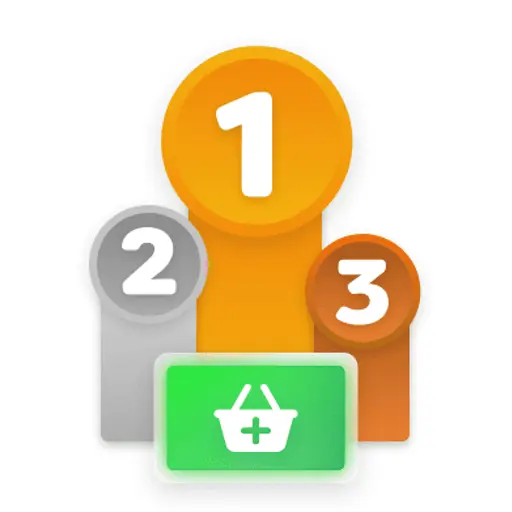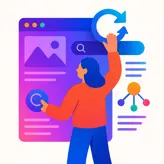
Ecommerce Content Optimization: A Guide to Outranking the Competition
Published July 8, 2024
Sitebulb welcomes back Sam Taylor, Technical SEO Lead at Evolved, to finish her comprehensive guide to outranking the competition, this time with ecommerce content optimization. If you haven’t yet read part one, here you go: Guide to Technical SEO for Ecommerce
Contents:
Content Optimization and Structured Data
Content optimization can not only be incredibly important for your rankings, but for your user experience as well. Every page you want to rank highly in search engines should contain relevant, useful information that helps the user with relevant, useful internal links.

Helpful Content
Google has released multiple helpful content updates over the years, designed to prioritize content created to help the user, rather than content created for search engines first. The first named update was released in August 2022, with Google publishing a blog post to help webmasters learn more.
Since then, there have been multiple updates of this nature. As of March 2024, this ranking system is now part of core updates.
To create people-first, helpful content you should avoid:
Content that is created in bulk using excessive automation
Content without a primary purpose or focus
Content that will leave the reader needing to know more to fully understand the topic
Content primarily designed to rank well in search engines only
Content that is written to a specific word count because ‘search engines have a preferred word count’ (spoiler: they don’t!)
If you’re producing content that is helpful for your user, you don’t need to worry. However, if you have seen a negative impact because of a helpful content update (now core update), you should reassess your content and make changes where you can improve. You can learn more about how to create people-first content here in Google’s documentation.
E-E-A-T is also important, and while not a ranking factor, is a component of Google’s search quality rater guidelines – a list used by ‘quality raters’ (real humans!) who assess the quality of content that Google ranks highly.
Although it’s a lengthy document, I’d highly recommend that anyone in SEO reads through the search quality rater guidelines. It will help you fully understand what Google is looking for when they are looking for quality web pages to rank and has influenced a lot of decisions I have made when it comes to SEO and overall website experience.
Informational Content
So, what does this mean for ecommerce websites? From my experience, ecommerce websites should invest heavily in informational content designed to help the user to show E-E-A-T. This content is separate from transactional pages.
Multiple studies have been completed on the correlation between information content and transactional rankings, including this one by Eoghan Henn, which found that commercial intent search queries can benefit from informational content pages, something which I have seen with multiple ecommerce clients myself.
Displaying this content in a hub, either as a separate folder or within the category structure can be extremely beneficial, like so:
Product category: Example.com/taps
Guide hub: Example.com/taps/guides
Guide URL: Example.com/taps/guides/how-to-install-a-kitchen-tap
If you are a website selling taps, there’s a good likelihood that your users are installing these themselves. You may want to create a step-by-step guide on exactly how to install a tap for DIYers to use, or they may need help choosing the right tap for their sink or kitchen design, which is again a piece of informational content you can publish to help them.
Ahrefs has published a great guide on content hubs if you’d like to learn more.

There are multiple benefits of doing your content hubs in this style, one of which is to aid link building efforts. Digital PR for ecommerce is especially tricky as it’s difficult to get natural links to category and product pages. However, by creating well-researched informational pieces, you create a natural way for sites to link to you, by offering expertise and helpful content, to support your overall strategy.
As Technical SEOs, our responsibility is to ensure that those linked content pieces contain links to other pages on the website, to allow PageRank to flow through the site.
Ensure your team undertakes keyword research around questions, or use tools like AnswerThePublic, to develop a content plan for your website. You can even take advantage of the user data you have to hand – your customers – and run polls or ask questions on social media for a response.
Informational content with an evergreen nature (useful all year round or time and time again) should be separated from topical content in my opinion, the main reason for this is so the evergreen content doesn’t get lost in the mix of more timely pieces. This is why I recommend implementing separate guide hubs within the product category, rather than using a site-wide blog. As a Technical SEO, you can work closely with all stakeholders to ensure this is configured correctly to work well.
Category Page Content
It's likely that your ecommerce website receives most of its traffic through category pages. For page types like these, you should add information to guide users with their transaction, but not too much. Google employees like John Mueller have advised time and time again to avoid stuffing too much content on your category pages, especially towards the bottom of the page because – let’s face it – no one’s reading that.
Providing some context for the user in the form of a blurb or FAQs is great, but making it into a long-form article at the bottom of the page isn’t useful for anyone – that’s where the informational content comes in.
Strategically link between informational and transactional content to ensure the user is fully informed before, during and after their purchase. Create a journey for the user to collect information, without needing to search other sites for sources, to not only strengthen your organic authority but improve conversions, too.
Word count isn’t something that you need to worry about, you should say what you need to say and nothing more. I have seen a 150-word blurb rank well when placed on a category page, because the content was concise, informative, and linked to longer-form content where relevant to help improve experience. I’ve also seen word counts much higher than this rank too, especially when the topic calls for more information.
The word count needed for your content is entirely dependent on what your products call for and what information is needed. Test things out, review what Google is currently ranking and try to find the sweet spot between what your users want and what they need.
AO.com has a great example of category content for eCommerce. Their content links to the main child categories and showcases a few of their best selling products. To complement this, they also provide some reviews and links to advice articles, where users can find more information to make an informed buying decision. Towards the bottom of the page, they include FAQ accordions with written copy.

Product page content
Product pages are also incredibly useful to optimize, though they aren’t an extremely high priority in terms of overall organic traffic. On average, product pages capture just 2% of the total share of voice of an eCommerce website, with category pages driving strong traffic.
As a minimum, I’d recommend product pages have unique, enticing titles and meta descriptions, as well as a product description (if these are unique, they will help you rank above the competition – but don’t worry, you can use the manufacturer’s description if you don’t have the resource to create them yourself just yet).
To take your product pages to the next level, you could look at how you’re internally linking to your informational content and see if links can be added to copy, or buttons can be placed to make it a helpful page or incorporate user-generated content like image carousels – anything to strengthen the E-E-A-T of your page.
IKEA is a great example of a quality product page – take the Malm chest of drawers; you can select the colour you’d like, view reviews, and see at a glance if delivery or collection is available. In addition, you can view measurements and UGC from Instagram, showing how other customers style products.

Topical Content
A lot of eCommerce websites have blogs, and my advice is to keep these topical. Did your company win an award, perhaps you’ve been named the best eCommerce website in your industry? Shout about it in your blog! Do you have an unmissable deal that your customers need to be aware of before it’s gone? Blog post! Round up of this season’s best dresses? Blog!
Anything short lived or likely to be outdated soon belongs in your blog. It helps not only to show that you’re active and committed to building relationships with your consumers but can also help prove your expertise within your niche and stand out against competitors. You can also create a content schedule to pair nicely with social media and other marketing strategies, too.
In terms of overall priority against all other types of ecommerce content, blogging is possibly the least important, especially when it comes to prioritizing your time. You’ll want to make sure your category, product and informational content are all up to standard before heavily focusing on your blog, as you may not see the results you want without this.
Thin, Missing & Duplicate Content
One crucial part of a technical SEO audit is to seek out pages missing content, or pages with very thin content. Duplicate content, like titles and on page copy, can be easily identified by many website crawlers, including Sitebulb, which provides a clear priority order to address issues.
Sitebulb’s on-page SEO analysis and scoring provides you with information on content elements that are too short or long, missing, or empty. With this, you can easily identify areas that need improvement. You can also easily find pages that contain dummy text, which may be crucial during migrations or site launches.

Structured Data
While using structured data doesn’t guarantee that you’ll be given the intended SERP feature, it can certainly improve your chances. Plus, it can also help Google better understand the contents of the page. There are many different types of structured data that can be used for ecommerce sites, and Google does a great job of summarizing them here.
Some of the most common types include:
Product
Product structured data is arguably one of the most important for ecommerce websites as it allows you to enrich your search results with features like:
Ratings: providing that you collect individual product reviews (not reviews for your business as a whole), these can be displayed on your search results as stars.
Price: price of the product can be shown directly in search, as well as any promotional prices or price drops.
Availability: whether the product is in stock or not.
BreadcrumbList
Breadcrumb trails are incredibly important and help Google to understand a page’s position within the site’s hierarchy, as well as allowing users to easily go back and navigate your pages. Using BreadcrumbList markup on these can help search engines categorize information easily in search results.
Please note that it is against Google’s structured data guidelines to markup content that is not visible to readers, or you may find yourself with a manual action.
Editor’s Note: You might like to read this guide on how to optimize for different types of featured snippets
SEO Content Tools and Resources
Let data inform your decisions, especially when it comes to website changes that can easily impact both user experience and search rankings. Below are some of the best resources I’d recommend.
Structured Data
Google’s rich results test can help you identify whether your webpages are eligible for featured snippets after implementing structured data.
Keyword Research Tools
I have used multiple keyword tools over my years in SEO and there’s no one-size-fits-all solution. Ahrefs is incredibly useful for transactional keywords, while I find that Semrush is particularly great for question queries, so both can be used for ecommerce purposes.
You can also use queries found in GSC to understand what users are searching for, though it will only show you queries you’re currently gaining impressions for, rather than opportunities and keyword gaps.
A lot of rank tracking tools, including STAT and Accuranker, have added keyword research features in the past couple of years, which provide recommendations specific to your website.
Other Useful Resources
An organization that I have been a member of since its inception is Women in Tech SEO. Originally started by the amazing Areej AbuAli to connect women in technical SEO, it has grown exponentially over the years to include most aspects of SEO, including content, and offers a safe space where you can go to ask questions, learn from others and make connections in the industry, whether you’re new to SEO or a seasoned professional.
Google has also provided a list of best practices specific to the ecommerce industry, where you can go to understand more about where ecommerce content can appear on Google, what relevant information you can share, information about URL structure and more. It is worth a read for anyone in this space.
I will always recommend Search Engine Roundtable to anyone in SEO, I have read it religiously for years. Barry is incredibly dedicated to ensuring the industry stays up to date with all the latest SEO developments (and tweets from Googlers!) – it is the place to go when you need concise information quickly.
Conclusion
A solid technical SEO foundation is essential for e-commerce success, but there’s also a lot you can do in terms of ecommerce content optimization to ensure you stand out online and achieve your ecommerce goals.
You might also like:

Sitebulb is a proud partner of Women in Tech SEO! This author is part of the WTS community. Discover all our Women in Tech SEO articles.

Sam has over 10 years of experience in SEO agency-side and has worked in all areas of SEO, from content to technical, specialising in e-commerce websites. She has previously spoken at industry events, including BrightonSEO’s Crawling and Indexation Summit.
Articles for every stage in your SEO journey. Jump on board.
Related Articles
 How to Stay Relevant in a World of AI Overviews & Query-Fans
How to Stay Relevant in a World of AI Overviews & Query-Fans
 Content Refresh Guide: How to Improve Your Search & AI Visibility
Content Refresh Guide: How to Improve Your Search & AI Visibility
 SEO for Growth Case Study: Revolutionizing a Saturated Market
SEO for Growth Case Study: Revolutionizing a Saturated Market
 Sitebulb Desktop
Sitebulb Desktop
Find, fix and communicate technical issues with easy visuals, in-depth insights, & prioritized recommendations across 300+ SEO issues.
- Ideal for SEO professionals, consultants & marketing agencies.
Try our fully featured 14 day trial. No credit card required.
Try Sitebulb for free Sitebulb Cloud
Sitebulb Cloud
Get all the capability of Sitebulb Desktop, accessible via your web browser. Crawl at scale without project, crawl credit, or machine limits.
- Perfect for collaboration, remote teams & extreme scale.
If you’re using another cloud crawler, you will definitely save money with Sitebulb.
Explore Sitebulb Cloud Sam Taylor
Sam Taylor


